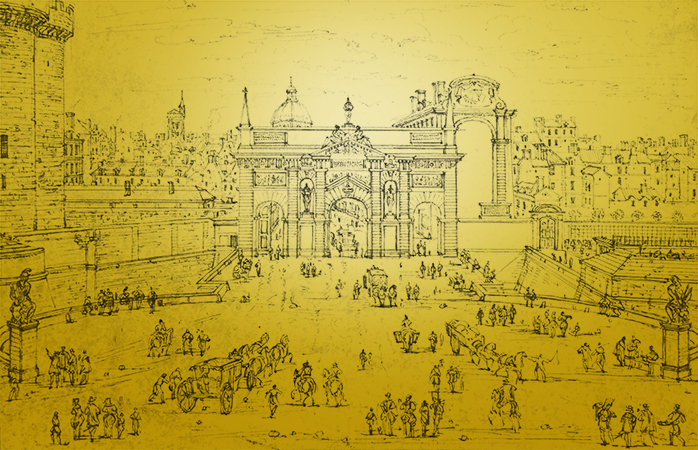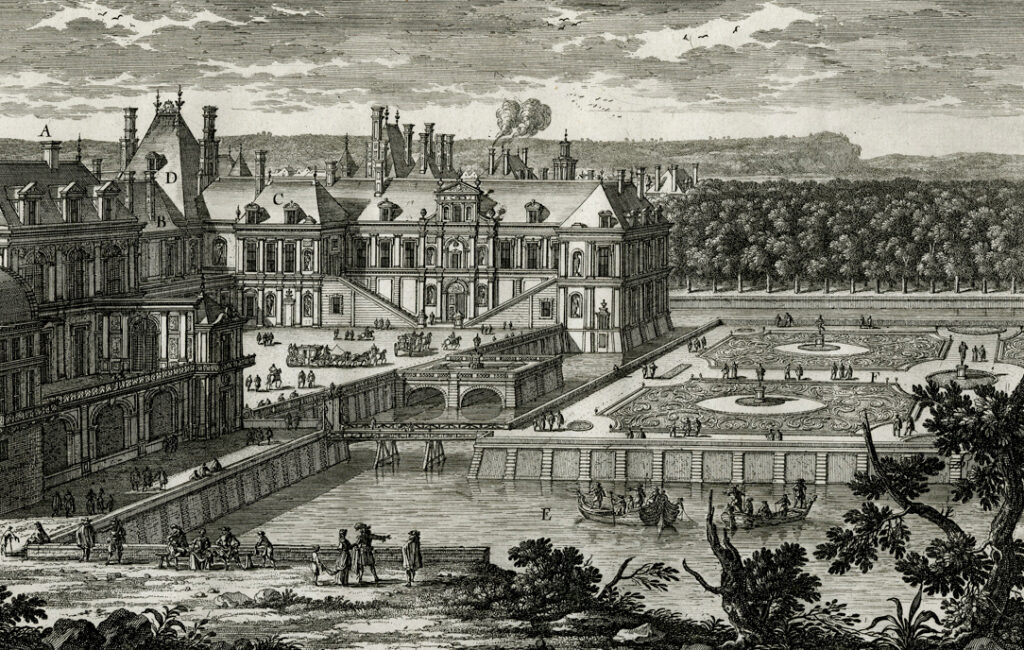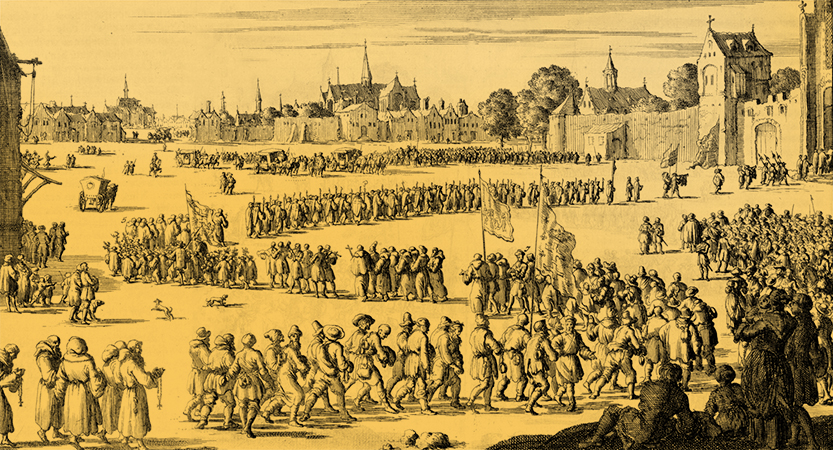Last week’s post here in this blog continued the origin story of Histoire de Babarie, the book written by Father Pierre Dan, the Trinitarian friar. That post ended with Father Dan, his Trinitarian brothers, and the freed captives arriving triumphantly in Marseilles from Tunis. After celebrating their success in Marseilles, they then set out on a grand public procession across France to Paris. We pick up the story this week from there.
Father Dan, his Trinitarian brothers, and the freed captives passed through Aix-en-Provence, Lambesc, Arles, Tarascon, and Avignon, all located in the Bouches-du-Rhône region near Marseilles. They then headed northwards to Lyon (about 180 miles/290 kilometers almost due north of Marseilles). From there, they travelled northwest some 125 miles/200 kilometers to Nevers. The next leg of their trek took them 100 miles/160 kilometers almost due north again to Fontainebleau, just south of Paris.
At each stop, they performed the same sort of dramatic public pageant they had in Marseilles. With the freed slaves and their entourage parading through the streets and the city squares. Crowds flocked to see the spectacle. Solemn masses were performed in each town and fervent sermons delivered—and, one presumes, alms gathered for the multitude of poor captives still enslaved.
Finally, after more than six weeks on the road, the group reached Paris. Paris was still a walled city in those days, and they entered through the Porte Saint Antoine, a gate at the city’s south end just next to the famous Bastille.

As they entered the city, they were met by a crowd of devotees, just as they had been when they came off the ship in Marseilles. They then trooped across the city, over the river to what is now the Rive Gauche, and onward to the Trinitarian church of St. Mathurin, near the Sorbonne, which was also the residence of the Father Superior of the Order, where they celebrated the captives’ redemption.
Here is Father Dan’s description:
____________________
We entered Paris by the Porte Saint Antoine at one o’clock in the afternoon on 20 May, 1635, and were received solemnly by the members of our house there, which is dedicated to St. Mathurin, who came to meet us with lit candles, and made a very beautiful public ceremony, forming a procession. Two archers wearing ceremonial jerkins and carrying halberds, accompanied by two beadles, marched at the head of the procession.
Eighty confreres of Notre-Dame de Bonne Délivrance followed them, barefoot, two by two, clothed in robes. They had laurel wreaths on their heads, and in their hands large white wax candles, each of which had a plaque attached to it on which could be seen a red & blue cross [1] between two palm branches. The friars came next, separated into two cohorts, followed by a quantity of city archers, in the same dress as those at the head of the procession.
This devout troop was joined by forty young children, who had been waiting in front of the Church of the Nuns of Saint Mary. They wore tunics of fine linen, held laurel branches in their hands, and had garlands on their heads. Next to them was a choir composed of excellent cantors from Notre-Dame and the Holy Chapel. As they were organized collectively, they came straight to the Porte Saint Antoine to receive us and the redeemed captives.
An unbelievably large crowd of people rushed pell-mell from all sides to see this procession, which made its way from the Porte Saint Antoine to our Church of St. Mathurin…
At the church, the Blessed Sacrament was performed. As we all entered inside, trumpets and organs sounded. Then our Reverend Father Superior, dressed in his habit, with a mantel overtop, formally received the captives, whom he kissed one after the other. They were then ranged around the Altar, where they made the prayers that are accustomed to be made in such a ceremony. Banners and pennants were displayed around the high altar, and the Te Deum was solemnly sung to music. Then, Monsieur Hubert, Abbot of Cerfroid, gave a learned and very eloquent sermon. [2]
____________________
A few days later, the liberated captives from Tunis were provided with formal certificates of redemption and some traveling money and finally sent home—much to their relief no doubt. They had been on the road for a month and half, obliged to wear slave costumes and play the central role in unending public parades. They must have grown heartly sick of the whole thing and yearned to return to their homes and families.
For the Trinitarians, however, the pageantry was the point. By making the risky trip to Tunis and returning with the ransomed captives, Father Dan and his colleagues had managed to transform the initial failure of the Algiers expedition into a spectacular public triumph for their Order.
In modern parlance, the Trinitarians had succeeded in re-branding themselves.
It was a triumph not only for the Trinitarians as a whole, but also for Father Dan himself.
__________
Father Pierre Dan was born in Paris around 1580 (the date is not exact). The details of his life are not entirely clear, but he seems to have earned a bachelor’s degree in theology from the University of Paris (the Collège de Sorbonne) and joined the Trinitarians around 1624, taking up residence in the Order’s premises in the château royal at Fontainebleau. This was an auspicious beginning to his career with the Order.
The buildings at Fontainebleau—a church and accompanying monastery—had originally been granted to the Order by the French King Louis IX in 1259, after he had been captured in Egypt and forced to pay an exorbitant ransom to free himself. This began a long tradition of close ties between the French Crown and the Trinitarians—one of the reasons why the Mercedarians’ attempt to infiltrate the French court had been seen as such a threat (and an insult).

Located as they were at the monarchial residence, the dwellings at Fontainebleau helped guaranteed (at least in theory) the Trinitarians’ continued access to royal patronage, influence, and power.
Father Dan must have been well respected—and well connected—to have been assigned there. Those connections apparently also facilitated his advancement, for the Order granted him the title of Father Superior of the Trinitarian monastery of l’Honor-Dieu, in Villeneuve-aux-Anes, near Chelles (located a little under 12 miles/20 kilometers west of Paris).
By Father Dan’s time, l’Honor-Dieu no longer actually existed, but this title nonetheless provided him with a reliable sinecure and gave him the right to vote in the General Chapter, the governing council of the Order, that met at Cerfroid. He was, in other words, an important and influential man within the Order well before his expeditions to Algiers and Tunis.
Father Dan was in his early fifties when he took part in those expeditions—of just the right age and stage in his career to advance within the Order to a more senior position. In December, 1634, he was appointed Father Superior at Fontainebleau. It is not entirely clear where he was at that moment. Perhaps he knew of this appointment before leaving Marseilles for Tunis. Perhaps he departed before the news could reach him and only heard about it upon his return.
In any case, the timing makes it clear that his promotion was not contingent upon a successful result from the Algiers expedition. Somebody—or several somebodies—in the upper echelons of the Trinitarian Order obviously had great confidence in him and were willing to give him an opportunity to prove himself.
That confidence appears to have been well placed, for not only did he managed to successfully ransom the forty-two Frenchmen in Tunis and parade them triumphantly across France, he went on to have a long and successful career as Father Superior at Fontainebleau, a position he held until his death in 1649, when he was close to seventy years old.
It was during his tenure as Father Superior that he wrote Histoire de Barbarie.
[1] The red and blue cross (the vertical arm of the cross in red, the horizontal arm in blue) was part of the distinctive iconography of the Trinitarian Order.
[2] Pierre Dan, Histoire de Barbarie, 1649, pp. 60-62.
____________________
For the next installment of the origin story of Histoire de Barbarie, see Father Pierre Dan: The Origin Story of Histoire De Barbarie – Part 6 here in this blog.

Corsairs and Captives
Narratives from the Age of the Barbary Pirates
View Amazon listing
The Travels of Reverend Ólafur Egilsson
The story of the Barbary corsair raid on Iceland in 1627
View Amazon listing